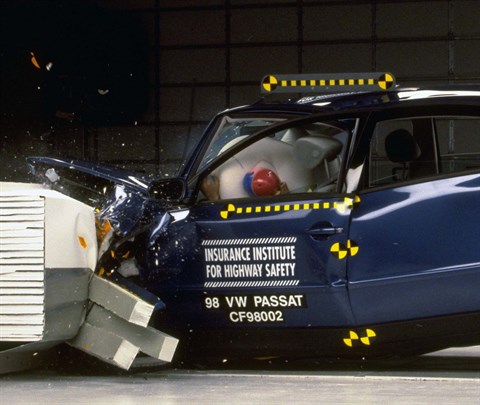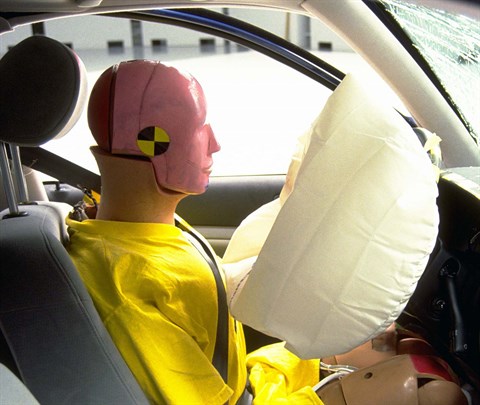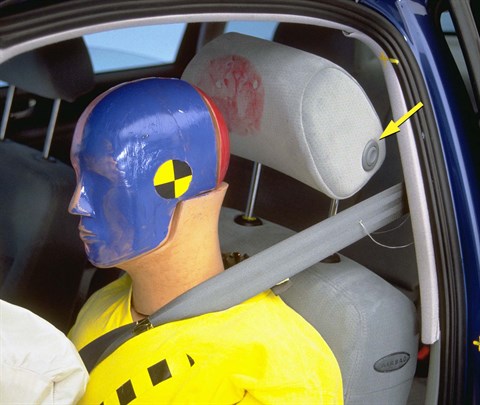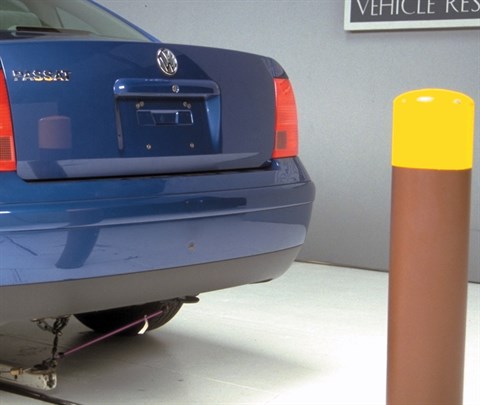Moderate overlap front: original test
Rating applies to 1998-2005 models
Tested vehicle: 1998 Volkswagen Passat GLS 4-door
The Volkswagen Passat was redesigned for the 1998 model year.
| Evaluation criteria | Rating |
|---|---|
| Overall evaluation | |
| Structure and safety cage | |
| Driver injury measures | |
| Head/neck | |
| Chest | |
| Leg/foot, left | |
| Leg/foot, right | |
| Driver restraints and dummy kinematics Dummy movement was reasonably well controlled. After the dummy moved forward into the airbag, its head moved toward the window sill as floor deformation tipped the driver seat toward the door. |
|

Action shot taken during the frontal offset crash test.

Despite some bending of the roof rail, the driver's survival space was maintained well.

A button on the side of the head restraint is for locking in position after the restraint has been adjusted upward. This design improvement was introduced during the 1998 model year. Still, the head restraint is marginal.

Minimal damage occurred in the most demanding bumper test, a 5 mph rear-into-pole impact.
Measures of occupant compartment intrusion on driver side
| Evaluation criteria | Measurement |
|---|---|
| Test ID | CF98002 |
| Footwell intrusion | |
| Footrest (cm) | 12 |
| Left (cm) | 16 |
| Center (cm) | 13 |
| Right (cm) | 10 |
| Brake pedal (cm) | 4 |
| Instrument panel rearward movement | |
| Left (cm) | 8 |
| Right (cm) | 7 |
| Steering column movement | |
| Upward (cm) | 9 |
| Rearward (cm) | 2 |
| A-pillar rearward movement (cm) | 4 |
Driver injury measures
| Evaluation criteria | Measurement |
|---|---|
| Test ID | CF98002 |
| Head | |
| HIC-15 | 160 |
| Peak gs at hard contact | no contact |
| Neck | |
| Tension (kN) | 1.7 |
| Extension bending moment (Nm) | 10 |
| Maximum Nij | 0.30 |
| Chest maximum compression (mm) | 28 |
| Legs | |
| Femur force - left (kN) | 3.7 |
| Femur force - right (kN) | 1.8 |
| Knee displacement - left (mm) | 5 |
| Knee displacement - right (mm) | 4 |
| Maximum tibia index - left | 0.37 |
| Maximum tibia index - right | 0.60 |
| Tibia axial force - left (kN) | 0.8 |
| Tibia axial force - right (kN) | 2.2 |
| Foot acceleration (g) | |
| Left | 50 |
| Right | 70 |
Head restraints & seats
Seat type: All seats
| Overall evaluation | |
|---|---|
| Dynamic rating | |
| Seat/head restraint geometry |
| Seat type | All seats |
|---|---|
| Geometry | |
| Backset (mm) | 100 |
| Distance below top of head (mm) | 58 |
| Seat design parameters | |
| Pass/fail | Fail |
| Max T1 acceleration (g) | 0.0 |
| Head contact time (ms) | |
| Force rating | 0 |
| Neck forces | |
| Max neck shear force (N) | |
| Max neck tension (N) | |
About the head restraint & seat test
Currently, IIHS tests apply only to front seats.
